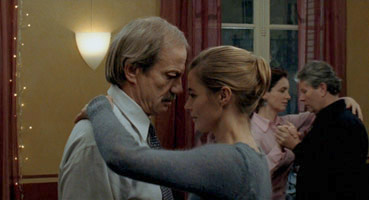|
Jean-Claude
Delsart is a man who gets little enjoyment or satisfaction
from life. He's middle-aged, in faltering health, and makes
his living as the head of a small, family-run bailiff company. It's a glum existence established in an opening
scene, in which he struggles up a long and winding flight of
stairs to serve notice on a woman for payment that she clearly
cannot afford. One day, he's in his office and he hears music
from the building opposite, and on looking across the way
sees a dance class in progress. The sight unexpectedly
captivates him, and a short while later he has enrolled
and is taking his first tango steps.
Also
in the class is the younger François, who recognises
Jean-Claude as the son of the woman who used to be her nanny.
The two exchange pleasantries, but over the course of the
following weeks their friendship grows, to the point where
it looks set to blossom into something more. For the ageing
divorcee Jean-Claude, this is potentially life-changing.
What he does not realise is that François is learning
the tango in order to dance at her own upcoming wedding.

There
is, it has to be said, more than a whiff of Shall
We Dansu? about Not Here to be Loved,
particularly in the central character of a weary working
professional whose life is transformed through involvement
with a dance class, an interest sparked by what they observe
through the window of the studio in which it is held. Both stories include an
attraction for a woman their respective leading men meet
through the class, a disruption to the relationship that they dream will develop,
and a reconciliatory ending that could almost have been
downscaled from Hollywood.
The
differences, however, are significant enough to allow Not
Here to Be Loved to stand without wobbling too
badly in its own dance shoes. Whereas in Shall We
Dansu? family man Shohei is captivated by the sight
of the beautiful Mai standing at the dance studio window,
for Jean-Claude it's the dancing itself that catches his imagination,
and his decision to join the class is prompted in part by his doctor's insistence that he get more exercise. The central attraction also
runs a notably different course here. Where in Dansu
Shohei is firmly discouraged from his pursuit of
Mai by Mai herself, the very idea of romance would never
even have occurred to Jean-Claude were it not for the persistent
first steps taken by François.
It's
in the development of this relationship that the film is
at its most beguiling. From the suppressed sensuality of
their dance practice to their hesitant, accidental
first kiss and Jean-Claude's almost adolescent apprehension
at their meetings, its sweetness lies not in an idealisation
of romance but in a refreshingly understated realism. And
it's not without it's lighter moments – looking to buy a
perfume for François, Jean-Claude finds one he likes,
but on being told that it's called 'Intense Passion'
he apprehensively responds, "Would you have the same
scent, but with a different name?'
Elsewhere,
however, the drama follows a more familiar path. A story arc
involving a jealous would-be gigolo with his own designs
on François treads well-worn turf in amiable but unsurprising fashion, as does the one involving Jean-Claude's son Jean-Yves, newly
recruited to a business he clearly despises. Similarly,
Jean-Claude's fractured relationship with his permanently
grumpy father (wonderfully played by veteran actor Georges
Wilson), though interesting in itself, comes to a somewhat
inevitable conclusion, and few will be completely surprised
by a later revelation involving a locked cupboard in the
old man's retirement home room. It's also become almost a
given that an age gap romance will involve an older male
and a younger female, while adherence to societal convention
will ensure that it is never likely to last (though the
final scene has a pleasing sense of ambiguity for the couple's
future).

Such
narrative safety-play steers Not Here to Be Loved
disappointingly clear of the more adventurous or challenging
ground to which its subject matter could have taken it.
That it is able to engage so effectively in spite of this
is down to the subtle confidence of the handling and some finely
judged performances from an impeccably chosen cast. Lead
players Patrick Chesnais and Anne Consigny in particular
are a joy, their mutual attraction as believably and touchingly
conveyed as their moments of frustration and emotional hurt.
For someone who too often finds screen romances shallow,
unconvincing and over-dramatised, that in itself is something
to celebrate.
There
have been some impeccable transfers on recent Artificial
Eye releases of European films, but this, unfortunately,
isn't one of them. Framed 1.85:1 and anamorphically enhanced,
the contrast is sound enough, but the picture has a slight
softness to it and the colours are sometimes on the drab
side. There are also some very visible compression artefacts
on areas of single colour, such as the blue door of the
flat in the opening scene, the office and dance studio walls
and the red backdrop of the show the class attend. It's
still very watchable, but not up to the usual standard.
You
have the option of Dolby 2.0 stereo and 5.1 surround tracks,
with the stereo track winning on volume and the surround
on subtlety, especially in its use of abient location sound.
The show music on the 5.1 track is particularly well mixed,
making the bass register without overdoing it. There's some
distinct separation on both tracks.
Interview
with Stéphane Brizé (33:36)
A chatty and informative interview with the director, punctuated
with flickering extracts from the film. The expected ground
is covered, including Brizé's own start in cinema,
the casting, the characters, the music and the dancing,
and there are a couple of interesting anecdotes thrown in
for good measure.
Interview
with Patrick Chesnais and Anne Consigny (25:59)
An enjoyable chat wit the two leads, whose obvious friendship
is enlivened by their personality differences, the deadpan
Chesnais contrasting nicely with the effervescent Consigny.
Both are sincere in their enthusiasm for the project, and
discuss in detail their interpretation of their characters.
Trailer
(1:40)
A decent, well edited sell.
Stéphane Brize, Patrick Chesnais and
Anne Consigny Filmographies
A little information-light, with only selected films for
the two actors.
Not
Here to be Loved plays its story a little safe,
but the evolving relationship at the film's core is deftly
handled and very nicely performed. The transfer is a little
below the usual Artificial Eye standard, but there's an
hour of enjoyable interview material in the extra features,
which does compensate a little. Worth seeing, and for some
it will definitely be worth buying.
|